In this kind of question the approach is to assume resultant resistance before and after basic unit and then treat it as a simple circuit, but here i am facing problem because here both inductor and capacitor given (not a single element circuit) which gives really complex result.
-
1You know in advance that if you add another inductor+capacitor pair to this infinite ladder that the impedance should not change. Right? After all, it is an ***infinite*** ladder. Does that help, at all? (And, of course, see: https://xkcd.com/356/ ) – jonk May 07 '17 at 05:15
-
yes i know but i am getting really complex form – user146551 May 07 '17 at 05:58
-
Imagine you have a series Z, already. Also, start your ladder with a capacitor to ground instead of the inductor. (Work it both ways.) You should get a quadratic, if I'm not mistaken. Substitute in the complex impedance terms. Should be a simple expression. – jonk May 07 '17 at 07:10
-
2It's basically the solution to the telegrapher's equations but without R and G being involved. See my answer here for a fairly simplistic solution: https://electronics.stackexchange.com/questions/83807/derivation-of-characteristic-impedance and note that your answer will not include R and G thus leaving impedance equal to \$\sqrt{L/C}\$ – Andy aka May 07 '17 at 09:33
1 Answers
Well, we know that:
$$\displaystyle\underline{\mathcal{Z}}_{\space\text{L}}=\text{j}\omega\text{L}\space\space\space\wedge\space\space\space\displaystyle\underline{\mathcal{Z}}_{\space\text{C}}=\frac{1}{\text{j}\omega\text{C}}\tag1$$
So:
- With \$1\$ capacitor and \$1\$ inductor: $$\displaystyle\underline{\mathcal{Z}}_{\space\text{in 1}}=\displaystyle\text{j}\omega\text{L}+\frac{\displaystyle1}{\displaystyle\text{j}\omega\text{C}}\tag2$$
- With \$2\$ capacitors and \$2\$ inductors: $$\displaystyle\underline{\mathcal{Z}}_{\space\text{in 2}}=\displaystyle\text{j}\omega\text{L}+\frac{\displaystyle\frac{1}{\text{j}\omega\text{C}}\cdot\left(\text{j}\omega\text{L}+\frac{1}{\text{j}\omega\text{C}}\right)}{\displaystyle\frac{1}{\text{j}\omega\text{C}}+\text{j}\omega\text{L}+\frac{1}{\text{j}\omega\text{C}}}\tag3$$
And that holds in general, so we get:
$$\displaystyle\underline{\mathcal{Z}}_{\space \text{n}}=\displaystyle\text{j}\omega\text{L}+\frac{\displaystyle\frac{1}{\displaystyle\text{j}\omega\text{C}}\cdot\underline{\mathcal{Z}}_{\space \text{n}-1}}{\displaystyle\frac{1}{\text{j}\omega\text{C}}+\underline{\mathcal{Z}}_{\space\text{n}-1}}\tag4$$
So, when \$\text{n}\to\infty\$ we get:
$$\displaystyle\underline{\mathcal{Z}}_{\space\infty}=\displaystyle\text{j}\omega\text{L}+\frac{\displaystyle\frac{1}{\text{j}\omega\text{C}}\cdot\underline{\mathcal{Z}}_{\space\infty}}{\displaystyle\frac{1}{\text{j}\omega\text{C}}+\displaystyle\underline{\mathcal{Z}}_{\space\infty}}=\displaystyle\text{j}\omega\text{L}+\frac{\displaystyle\underline{\mathcal{Z}}_{\space\infty}}{\displaystyle1+\displaystyle\text{j}\omega\text{C}\underline{\mathcal{Z}}_{\space\infty}}\space\Longleftrightarrow\space$$ $$\underline{\mathcal{Z}}_{\space\infty}=\frac{\displaystyle\text{C}\cdot\text{L}\cdot\omega\cdot\text{j}\pm\sqrt{\text{C}\cdot\text{L}\cdot\left(4-\text{C}\cdot\text{L}\cdot\omega^2\right)}}{\displaystyle2\cdot\text{C}}\tag5$$
As an example, when \$\text{C}=\text{L}=10^{-12}\$ and \$\omega=2\pi\cdot10^9\$:
$$\displaystyle\underline{\mathcal{Z}}_{\space\infty}=\frac{\displaystyle\pi\cdot\text{j}\pm\sqrt{10^6-\pi^2}}{\displaystyle10^3}\tag6$$
- 7,203
- 12
- 21
